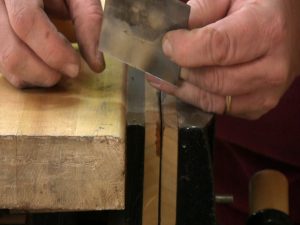 Cabinet scrapers are the bigger, badder, much more aggressive brother to the card scraper. When you have a large surface to clean up, the cabinet scraper can be your best friend.
Cabinet scrapers are the bigger, badder, much more aggressive brother to the card scraper. When you have a large surface to clean up, the cabinet scraper can be your best friend.
Because the tool is scraping and not slicing, grain direction is far less important than on a plane. That said, you can’t use a cabinet scraper cross-grain like you can a plane.
Sharpening Cabinet Scrapers
 Because the cabinet scraper is more aggressive than the card scraper, we approach sharpening a little differently. Grind the edge on a 45° angle. Most of the time, in my shop, I use my stationary disc sander and a jig that fits into the miter gauge slot to rough out the angle. But I realize not everyone has a stationary sander; in the video, I show how to get there using a file.
Because the cabinet scraper is more aggressive than the card scraper, we approach sharpening a little differently. Grind the edge on a 45° angle. Most of the time, in my shop, I use my stationary disc sander and a jig that fits into the miter gauge slot to rough out the angle. But I realize not everyone has a stationary sander; in the video, I show how to get there using a file.
 The first thing you need to do is create a gauge block. Typically, I use a piece of scrap 8/4 material slightly wider than the blade with the end cut at 45°. Use the block not only as a gauge for filing but on the whetstones for honing. The angle doesn’t need to be perfect, close will do. Using a gauge block makes the process repeatable and easy.
The first thing you need to do is create a gauge block. Typically, I use a piece of scrap 8/4 material slightly wider than the blade with the end cut at 45°. Use the block not only as a gauge for filing but on the whetstones for honing. The angle doesn’t need to be perfect, close will do. Using a gauge block makes the process repeatable and easy.
When filing, grinding or sanding the bevel, the most important part is to remove any remnants of the old burr. And when honing, I like to whet the edge to #4000-grit. Some say you don’t need to take it so far because you’re mashing the edge over with a burnisher, but I find the tool leaves behind a smoother surface when I do.